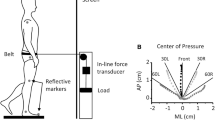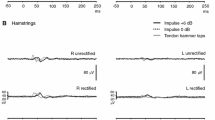Summary
This study examined the EMG onsets of leg, trunk, and neck muscles in 10 standing human subjects in response to support surface anterior and posterior translations, and to plantar and dorsiflexion rotations. The objective of the study was to test the hypothesis that the responses radiating upward from distal leg muscles represent part of a large ascending synergy encompassing axial muscles along the entire length of the body. If these responses are not ascending, then the muscles of the neck, and possibly the trunk, can be independently activated by vestibular, proprioceptive or visual inputs. We analysed the timing of postural muscle responses within and between body segments in order to determine whether they maintained a consistent temporal relationship under translational and rotational platform movement paradigms. Our results did not strongly support an ascending pattern of activation in all directions of platform perturbation. Temporal differences between activation patterns to platform perturbations in the forward or backward directions were revealed. In response to posterior platform translations we observed an ascending pattern of muscle responses along the extensor surface of the body. In addition, responses elicited in the neck flexor and abdominal muscles occurred as early as those of the stretched ankle muscles. This pattern of upward radiation from stretched ankle muscles was not as clear for anterior platform displacements, where early neck flexor muscle responses were observed during the ascending sequence on the flexor surface of the body. Platform rotations caused fewer responses in the neck and upper trunk muscles than translations, and all muscle responses occurred simultaneously rather than sequentially. Probable differences in the stimulation of vestibular and neck proprioceptive inputs and the mechanical demands of the rotation and translation paradigms are discussed.
Similar content being viewed by others
References
Allum JHJ, Keshner EA (1986) Vestibular and proprioceptive control of sway stabilization. In: Bles W, Brandt T (eds) Disorders of posture and gait. Elsevier/North-Holland Biomedical Press, Amsterdam Oxford New York, pp 19–40
Allum JHJ, Pfaltz CR (1985) Visual and vestibular contributions to pitch sway stabilization in the ankle muscles of normals and patients with bilateral peripheral vestibular deficits. Exp Brain Res 58: 82–94
Allum JHJ, Keshner EA, Honegger F, Pfaltz CR (1988) Organization of leg-trunk-head equilibrium movements in normals and patients with peripheral vestibular deficits. In: Pompeiano O, Allum JHJ (eds) Progress in brain research: vestibulospinal control of posture and movement. Elsevier/North-Holland Biomedical Press, Amsterdam Oxford New York (in press)
Bernstein N (1967) The coordination and regulation of movement. Pergamon Press, New York
Buchanan TS, Almdale DPJ, Lewis JL, Rymer WZ (1986) Characteristics of synergic relations during isometric contractions of human elbow muscles. J Neurophysiol 56: 1225–1241
Bussel B, Katz R, Pierrot-Deseilligny E, Bergero C, Hayat A (1980) Vestibular and proprioceptive influences on the postural reactions to a sudden body displacement in man. In: Desmedt JE (ed) Spinal and supraspinal mechanisms of voluntary motor control and locomotion. Progress in Clinical Neurophysiology, Vol 8. Karger, Basel Paris London New York, pp 310–322
Diener HC, Bootz F, Dichgans J, Bruzek W (1983) Variability of postural “reflexes” in humans. Exp Brain Res 52: 423–428
Diener HC, Dichgans J, Bootz F, Bacher M (1984) Early stabilization of human posture after a sudden disturbance: influence of rate and amplitude of displacement. Exp Brain Res 56: 126–134
Gurfinkel VS, Lipshits MI, Popov KE (1974) Is the stretch reflex the main mechanism in the system of regulation of the vertical posture in man? Biophysics 19: 761–766
Keshner EA, Allum JHJ (1986) Plasticity in pitch sway stabilization: normal habituation and compensation for peripheral vestibular deficits. In: Bles W, Brandt T (eds) Disorders of posture and gait. Elsevier/North-Holland Biomedical Press, Amsterdam Oxford New York, pp 289–314
Keshner EA, Allum JHJ, Pfaltz CR (1987) Postural coactivation in the sway stabilizing responses of normals and patients with bilateral vestibular deficit. Exp Brain Res 69: 77–82
Lee RG, Murphy JT, Tatton WG (1983) Long-latency myotatic reflexes in man: mechanisms, functional significance, and changes in patients with Parkinson's disease or hemiplegia. In: Desmedt JE (ed) Motor control mechanisms in health and disease. Raven Press, New York, pp 489–508
Nashner LM (1976) Adapting reflexes controlling the human posture. Exp Brain Res 26: 59–72
Nashner LM (1977) Fixed patterns of rapid postural responses among leg muscles during stance. Exp Brain Res 30: 13–24
Nashner LM, Berthoz A (1978) Visual contribution to rapid motor responses during posture control. Brain Res 150: 403–407
Nashner LM, McCollum G (1985) The organization of human postural movements: a formal basis and experimental synthesis. Brain Behav 8: 135–172
Nashner LM, Black FO, Wall C III (1982) Adaptation to altered support and visual conditions during stance: patients with vestibular deficits. J Neurosci 2: 536–544
Nashner LM, Woollacott MH, Tuma G (1979) Organization of rapid responses to postural and locomotor-like perturbations of standing man. Exp Brain Res 36: 463–476
Roberts TDM (1978) Neurophysiology of postural mechanism, 2nd edn. Butterworths, London Boston
Rozendal RH (1986) Biomechanics of standing and walking. In: Bles W, Brandt T (eds) Disorders of posture and gait. Elsevier/North-Holland Biomedical Press, Amsterdam Oxford New York, pp 3–18
Schmidt RA (1982) Motor control and learning. Human Kinetics, Illinois
Stockwell CW, Koozekanani SH, Barin K (1981) A physical model of human postural dynamics. In: Cohen B (ed) Vestibular and oculomotor physiology. Ann NY Acad Sci 374: 722–730
Vídal PP, Berthoz A, Millanvoye M (1982) Difference between eye closure and visual stabilization in the control of posture in man. Aviat Space Environ Med 53: 166–170
Wicke RW, Oman CM (1982) Visual and graviceptive influences on lower leg EMG activity in humans during brief falls. Exp Brain Res 46: 324–330
Author information
Authors and Affiliations
Rights and permissions
About this article
Cite this article
Keshner, E.A., Woollacott, M.H. & Debu, B. Neck, trunk and limb muscle responses during postural perturbations in humans. Exp Brain Res 71, 455–466 (1988). https://doi.org/10.1007/BF00248739
Received:
Accepted:
Issue Date:
DOI: https://doi.org/10.1007/BF00248739




